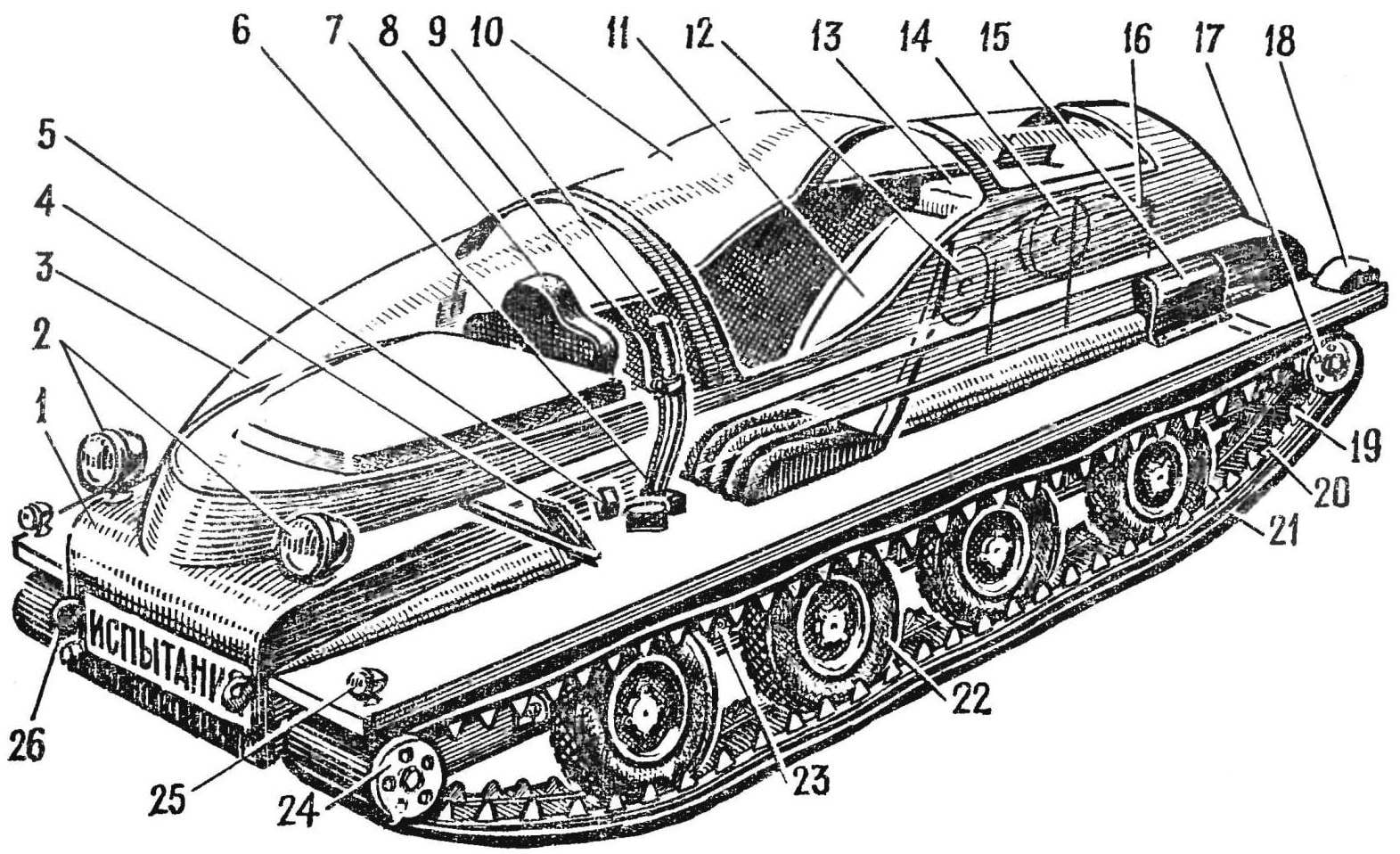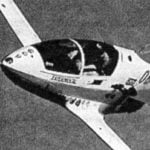 Central to the exhibition NTTM-78, dedicated to the XVIII Congress of the Komsomol, and the 60th anniversary of the Komsomol, very popular among the visitors enjoyed the section “Eureka”, in which he demonstrated unusual vehicles created by Amateur designers. Wheeled-tracked all-terrain vehicle “Arctic”, built as an electrician from Rybinsk Valery Medvedev, was one of those cars that arrived in Moscow on VDNH USSR “his way.” Yes, it was not a model but a live working machine, figuratively, “discontinued operation” in the household of his Creator. Summer and winter, heat and cold, hunting and fishing, just outside the city with your family or on urgent business drives this original machine designer. Already more than fifty thousand kilometers was “Polar”. The mileage is respectable, even for production vehicles.
Central to the exhibition NTTM-78, dedicated to the XVIII Congress of the Komsomol, and the 60th anniversary of the Komsomol, very popular among the visitors enjoyed the section “Eureka”, in which he demonstrated unusual vehicles created by Amateur designers. Wheeled-tracked all-terrain vehicle “Arctic”, built as an electrician from Rybinsk Valery Medvedev, was one of those cars that arrived in Moscow on VDNH USSR “his way.” Yes, it was not a model but a live working machine, figuratively, “discontinued operation” in the household of his Creator. Summer and winter, heat and cold, hunting and fishing, just outside the city with your family or on urgent business drives this original machine designer. Already more than fifty thousand kilometers was “Polar”. The mileage is respectable, even for production vehicles.
The first time, the local traffic police officials kept an eye on the Rover Medvedev incredulously. Tractor a tractor, the plane is not a plane. Well “running” fit in the flow of vehicles on the streets, collide with the rules of the road. After some time everyone got used to the “Polar Explorer”. He became sort of a local attraction, if not proud Rybinsk “zamotaylov”. From the far Northern lands have begun to receive letters to come “walkers” — everyone was eager to drawings or even photos of this amazing vehicle. Receive such correspondence, and the editorial Board of our journal. So today, when behind the exhibition NTTM-78, where hundreds of thousands of visitors could see “Polar Explorer” and the winner of which was Valery Medvedev, we introduce to his car.
Create a true all-terrain machine is a very tempting idea! I carried her for several years: it took about a year to design and three years to build. In the summer he worked in the yard, in the shed in winter the apartment. Well, that home is not very grumbling, sometimes even helped and supported me morally. Otherwise I would never have finished this work!

Fig. 1. Microvideo Polyarnik.
For a basis I have taken wheel-tracked chassis with two side rows of pneumatic tire and wheel assemblies 4X10 (scooter), 4 wheels in each row. The wheels are covered with caterpillars with two rows of guide canines for 110 pieces each.
The drive was originally installed the engine UD-4 with a capacity of 12 HP with a homemade transmission. Later I replaced it with engine from motoart “Buran” with a power of 25 BHP at 3600rpm min in combination with V-belt variator. General view of the Rover “Polar Explorer” is shown in figure 2, the scheme in three dimensions and the basic dimensions in figure 1.
Rover frame truss-type made of duralumin area and in some areas reinforced with inlays of beech bars.
The hull boards of furniture plywood veneered in single layer fiberglass, ASTT(b) epoxy resin. The lower housing is sealed, the top consists of two halves that gives you the opportunity rasstegivat her for 10-15 min and get unrestricted access to any site and Assembly.
The frame has four axles with eight cylinders; independent suspension of each cylinder is carried out using an l-shaped lever, rotating in the sliding bearing. When hitting the wheels on the obstacle, the lever transmits the force on the coil spring suspension.
The caterpillar of rubber-fabric belts (from written-off conveyor) equipped with a homemade plastic teeth made by injection of nylon. The lugs of the steel rod Ø 8 mm caterpillar provide the lateral stiffness and the desired grip. The fangs are attached to the caterpillar through bolts M8.

Fig. 2. The overall layout and details.
A — 3/4 front: 1 — body, 2 lights, 3 to the fixed part of the lamp 4 — left foot pedal, 5 — the switch of turn indicator, 6 — stop light switch, 7 — panel, 8 — throttle lever, 9 — knob control, 10 — movable part of the lantern, 11 — back driver seat, 12 — drive pulley variator, 13 — motor, 14 — the driven pulley of the CVT (on starboard side), 15 — air inlet, 16 — the case of the main transmission, 17 — driving wheel, 18 — marker lamp, 19 — Fang caterpillars, 20 — enhancing the contribution of 21 — caterpillar, 22 — bus 4X10, 23 — wheel suspension, 24 — Lenivets, 25 — position, 26 — tow eye. B — cheek drive wheel n reel idler (steel 20, 5 mm thick) sprocket (glass fiber with a thickness of 10 mm). G — installation of fangs on the caterpillar: 1 — Fang, 2 bolts M8, 3 — caterpillar, 4 — reinforcing tape. D — scheme suspension wheels: 1 — G-obraznym lever 2 — lever axle, 3 — axle wheels, 4 — wheel, 5 — fangs, 6 — the caterpillar 7 — lever (side view), 8 — wheel hub; top shows grouser steel rod Ø 8 mm.

Fig. 3. Equipment cab:
1 — front lamp, 2 — panel, 3 — power frame housing, 4 throttle, 5 — handle, 6 — the driver’s seat, 7 — the lever of the reverse, 8 — seat 9 — brake light switch, 10 — switch of turn indicators, 11 — pedal foot control.
The transmission is arranged as follows: the output axle shaft axle splined sleeve associated with the drive shaft. On the outer diameter of each sleeve pressed onto the brake drum. Steering and braking are carried out with the help of two foot pedals. If you press any pedal related hard thrust moves back and presses on the lower part triplezero lever, the upper end of which is rigidly connected to the band brake. Tape Ferodo, facilitates drum, holds the shaft from rotation, and due to the differential pinion gears opposite (right) shaft at this point rotates freely, and the car makes a left turn. The right turn is performed similarly to the left, and to stop the vehicle it is necessary to reduce the engine speed and the pressure of the feet on the pedals; since the track designs have a very small reel, the braking distance will not exceed two to three meters. To control the gas and turning signals to the cab driver removed the lever (handle aircraft type) with longitudinal and transverse displacement.
To the bottom of the lever is attached a cable connected with the throttle valve of the carburettor: when applying the handle from itself, the throttle valve opens itself — closes. By moving the handle right or left are included the corresponding indicator and warning lamp (“flasher”) on the dashboard. When fully assumed the handle turns on the taillight.
The driver’s seat of aircraft type, with adjustable height and length, equipped with seat belts. On the control panel to located the Rev counter (tachometer), temperature gauge cylinder head, benzinger and aviation compass KEY 12. On the control panel electrical system — ignition switch, headlight switch. Horn button on the handle.
The machine was easy to fly, quite maneuverable and very hardy. So, the loaded chassis parts — caterpillar — after driving 50 thousand miles without needed repairs. A flotation of the “Polar Explorer” is much higher than the trucks with the front axle, not to mention the motorcycles with sidecars and conventional cars.
V. MEDVEDEV, Rybinsk



